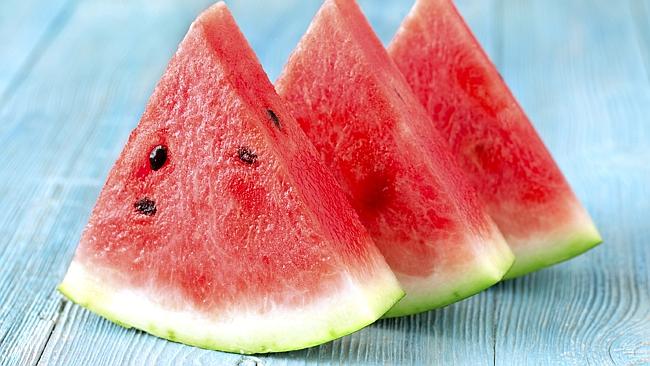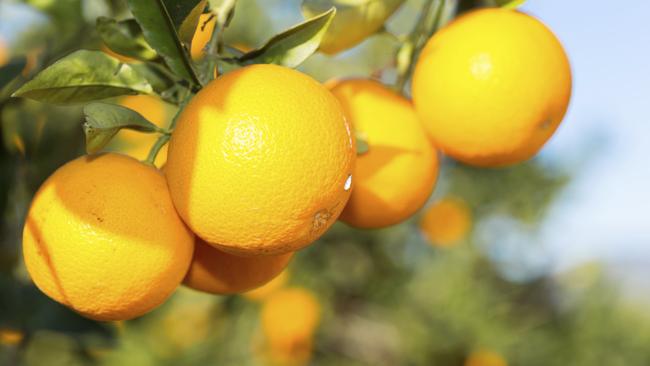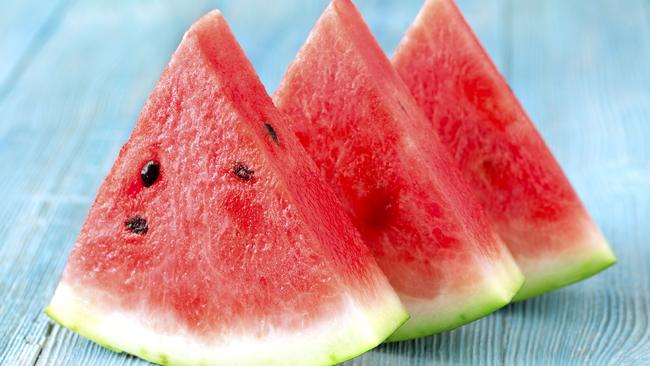The dieting ‘F’ word: Is fructose in fruit making us fat?
FRUIT has long been thought of as a healthy option, but new research into fructose has us confused. Is fruit actually contributing to obesity?

Health
Don't miss out on the headlines from Health. Followed categories will be added to My News.
FRUCTOSE is like the F-word these days with many blaming it for the rising rates of
obesity and other health problems. But in the rush to avoid the sweet stuff, does this mean you avoid fruit?
What is fructose?
Fructose, in its pure form, is a simple sugar found naturally in fruit. It’s also found in honey, maple sugar, some vegetables (e.g., onions, potatoes), some grains (e.g., wheat, rice, barley and rye), and it makes up half (50 per cent) of sucrose (table sugar) — the most common form of ‘added sugar’ to processed food and drinks, and consequently a major source of fructose in Australia. Making headlines this week was a small study published in the PNAS, which showed that fruit sugars ‘may worsen food cravings’.
Why? The study suggests that fructose, compared to glucose, activates regions in the brain involved in attention and reward, which in turn bring on a feeding frenzy.
Subjects in this study consumed a sugary drink sweetened with fructose on one day and glucose on another day. Compared with glucose, the fructose drink led to increased hunger and desire for sugary foods suggesting different sugars behave differently in the body.
This study adds to previous research that shows large amounts of fructose triggers processes in the body like fat accumulation around the belly, a rise in triglycerides (harmful blood fats that increase the risk of a heart attack), an increased risk of insulin resistance (the precursor to diabetes), as well as liver toxicity.

Should we worry about consuming too much fructose?
First of all, the problem with studies pointing the finger at “fructose” is that it doesn’t paint the whole picture. The reality is we rarely eat pure refined fructose in isolation (except exclusively in fruit), let alone in the amounts required to cause adverse health problems. In other words, it’s impossible to overeat fructose by eating fruit.
Secondly, eating fructose or glucose in isolation is very different to eating them within the context of a food. For example, whole fruits — along with its naturally occurring fructose is packaged up with a bounty of antioxidants and diluted with water and other nutrients giving metabolic advantages such as slow digestion and satiety (feelings of fullness).
What’s more, most of the research concerning the effects of fructose has used very high doses — much more than people would normally eat in real life.
For example there is evidence that consuming large amounts (> 24 teaspoons) of pure refined fructose a day on top of a regular diet might be converted to fat — but experts would argue this is most likely from the extra calories.
Needless to say, there is strong evidence to shows increasing sugar — in sweetened beverages, including fruit juice — does cause modest weight gain. That’s because fruit juice is basically a concentrated source of sugar and chances are guzzling down liquid calories in juice is not compensated by a reduction in calories from other foods. Fruit juices are also acidic and frequent
consumption may increase the risk of dental decay. This is why nutritionist always recommend choosing whole fruit over fruit juice. Similarly, dried fruits (like sultanas) are also a concentrated source of sugar, and likewise with fruit juice are easy to consume large amounts.
How much is too much?
There are currently no specific recommendations for fructose but there are for sugars in general. Consuming no more than 10 per cent of total energy intake, or less than 13 teaspoons of added sugar for an average Australian, which is similar to that recommended by the World Health Organisation (WHO). However, the WHO states that a further reduction to below 5 per cent or roughly 25 grams (6 teaspoons) per day would provide additional health benefits.
As for fruit, Australians are encouraged to adopt a “5 + 2” approach — that is, five portions of vegetables and two of fruit every day. A standard serve of fruit is equal to one apple or banana, or two small pieces of apricots or kiwis. As for fruit juice or dried fruit, a standard serve is equal to 125ml (½ cup) fruit juice (no added sugar) or 30g dried fruit (for example, 4 dried apricot halves, 1½ tablespoons of sultanas) and the Guidelines do recommend consuming these
only occasionally.

When fruit should be avoided
While fruit is healthy for most people, there are some circumstances where people should avoid certain types, such as those following a low FODMAPS (Fructose, Oligo- Di- and Mono-saccharides and Polyols) diet — a complex name for a collection of molecules found in food, that can be poorly absorbed by some people, usually with Irritable Bowel Syndrome (IBS). Still, this diet is to be undertaken under medical supervision.
Do you need to quit fructose?
Anti-sugar crusaders would have you think so. Just take a look at some of the recipes in popular anti-sugar cookbooks and not a drop of fructose in sight. Ironically, they do not recommend the complete avoidance of all sugars. In fact, they are recommending that people replace all things fructose with other added refined sugars like glucose/dextrose and rice syrup which are still sugars and provide more kilojoules than fructose, still contribute to tooth decay, and cause a
much higher spike in blood glucose levels because of its high glycaemic index.
Bottom line:
For most people, the benefits of eating fruit outweigh any disadvantages posed by its sugar content — hence why cutting fruit is not necessary for those wanting to cut down on sugar. However, if your diet contains a lot of sweetened processed food including cakes, biscuits, coated muesli bars or low-fat snacks, washed down with fruit juice, then you’re probably consuming a lot of fructose.
In which case, you would see great health benefits by replacing some of the junk
with a piece of fruit.
Kathleen Alleaume is an exercise and nutrition scientist (MSc) and Author of
What’s Eating You? @therightbalance
Originally published as The dieting ‘F’ word: Is fructose in fruit making us fat?







